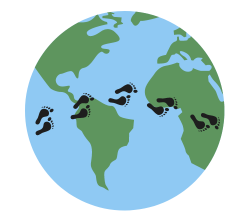So you want to start a blog … Starting a blog is a wonderful way to express yourself, build your writing portfolio and educate people about living a sustainable lifestyle, or whatever topic interests you.
I’m not going to lie: Starting a blog is a lot of time and effort, both for the initial setup and for the ongoing work of writing and publishing posts. However, there’s nothing quite like seeing your blog up and running on your corner of the internet!
There are different approaches to starting a blog. This guide shares the overall process I followed to start my blog, Steps Toward Sustainability. There are lots of articles that dive into the technical details of starting a blog if you need more details on any of the steps!
How to start a blog
The overall steps for starting a blog include doing research and technical setup; establishing your visual style; setting up social media accounts (optional); and making an editorial calendar. Read on to learn about each of these steps in more detail!
Do the groundwork
Before publishing your first post, you’ll want to do some thinking and behind-the-scenes work. This will set your blog up for success and ensure it achieves the goals you set for it!
Choose a topic: First things first, choose a topic for your blog! Maybe you already have an idea, or maybe you’ll need to brainstorm topics that interest you. The topic should be specific but not too niche and something you are knowledgeable about and interested in—in other words, something you can see yourself writing multiple posts about!
Choose a name: The name for your blog should be short and memorable and capture the essence of your topic. No pressure, right? You should also make sure the name is not already in use. If, like me, you are terrible at coming up with names, try brainstorming keywords related to your topic and then using a free blog name generator for inspiration.
Think about your goals and why you are starting a blog: Do you want to make a living from your blog, sell products or simply educate people on a topic you’re passionate about? Knowing why you are starting a blog will inform some of the decisions you make down the road. For example, I knew that I wasn’t trying to make a living from my blog and didn’t like the look of blogs that were full of ads, so I chose not to include ads on my blog.
Think about your target audience: Who do you want to reach with your blog? Consider characteristics like their demographics, location, life stage, use of technology and interests. This will help inform things like the topics for your posts, the look of your blog and which platforms you use for promotion.
Research other blogs for inspiration: Research other blogs on a similar topic. See what kind of topics they write about and how their blog is laid out. What do you like, and what would you do differently for your blog?
Get technical (set up your website)
There’s no getting around it: Starting a blog will involve some technical work. However, there are some shortcuts if technology is not your strong suit.
Choose your content management system: A content management system (CMS) is a type of software that allows you to publish, edit and organize your content (in this case, blog posts). The most popular software for blogging is WordPress, but there are several other options, including Squarespace and Wix. You could also take the easy route and use a tool like Medium or Substack, which will take care of much of the technical work for you!
If you’re using WordPress: You will need to choose a theme, which governs the look and feel of your website. You should also install plugins, which add extra functionality to your website. A few basic plugins you may want to add are:
- Yoast (search engine optimization)
- Akismet (anti-spam)
- MonsterInsights (analytics on your blog)
- A plugin for sending email newsletters, such as MailPoet or Kit
Choose a website hosting service: A website host is a service that makes your blog available on the internet. Basically, they store your website’s content on a secure server. You can check out this list of free and low-cost web hosting services. Personally, I’m using DreamHost and don’t have any complaints!
Register your domain name: Your domain is your blog’s specific location on the internet—basically its website address or URL. You’ll need to register it to make sure no one else uses the same one. Thankfully, domain registration is often included in your package for web hosting!
Set up your website layout: Choose the layout for your website and add a menu. Besides the blog posts themselves, a few pages or elements you may want to include are: an about page/bio, a contact page and a search bar.
Establish your visual style and set up social media accounts
This is the fun part! Choosing specific colours and fonts for your blog will ensure that your content looks consistent. You may also choose to set up social media accounts to reach a wider audience.
Design your logo: Most likely, you will want to have a logo for your blog! This can be added to your website and social media accounts. You can design one fairly easily using a free design software like Canva. Include the name of your blog and a graphic element that represents your topic.
Choose your colours and fonts: Choose a handful of colours and fonts to use for your blog. Using consistent colours and fonts will ensure that your content looks consistent across different platforms. Make sure that the colours go well together and the fonts are legible.
Find photos for your blog: Use free photo databases like Pexels and Unsplash to find stock photos for your website. If you want to take photos yourself, check out this article on taking better photos with a phone.
Set up social media accounts for your blog: If you have the bandwidth, you may want to set up social media accounts to share your blog posts. This will help you reach a wider audience. Choose the platforms that are most relevant for your target audience. Here are a few things to consider related to blog social media accounts:
- Choose a social media scheduler—like Hootsuite, Buffer or Later—so you can schedule social media posts
- Set up a link in bio tool for Instagram so you can share the links to blog posts easily
- Follow social media accounts related to your topic
- Make graphic templates using Canva to make it more efficient to share your blog posts
- Think about whether you’ll want to post additional content beyond sharing your blog posts
Make an editorial calendar and publish your first post!
Creating an editorial calendar will ensure that you stick to a schedule and publish posts consistently. Don’t worry, it’s not hard!
Brainstorm ideas for posts: Start a list of ideas for blog posts, whether in a document, a physical notebook or on your phone. This is where your research into other blogs may come in handy (though you don’t want to copy topics exactly). You can add to your list as you go along as more ideas come to you! I find ideas for posts often come to me as I’m going about my day-to-day life.
Make an editorial calendar: At its most basic, an editorial calendar should include the topics for blog posts and their planned publication date (you can get more detailed if you like). Think about how often you can realistically write and publish a post. You’ll want to publish at a consistent cadence so your readers know what to expect, without burning yourself out. When planning content, you can also think about whether there are any holidays or seasonal dates you can line up with.
Write and publish your first post: Do some research into the topic and develop an outline. Then you can sit down and write the post! Since this is your first blog post, you may want to get a close friend or family member to review it to make sure it reads well. Then you are ready to publish and promote your post. Congratulations! Your first blog post is now live.
The process to start a blog
And there you have it! That’s the general process for starting a blog. It may seem like a lot of work, but it’s manageable if you break it down into smaller steps. You will discover your own process as you go along and may decide to do certain things differently. Remember: The end result will be very rewarding!
Best of luck!
I want to know: Have you started a blog before? What was your process like? Do you have any tips?
Categories and tags:
Share this post:

